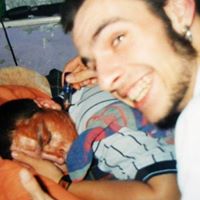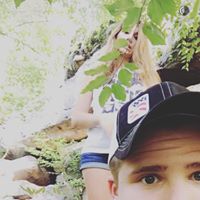Nathan M Wolfe
age ~70
from Fayetteville, TN
- Also known as:
-
- Nathan W Wolfe
- Nathan N Wolfe
- Nathan Miller Wolke
- Nate Wolfe
- Nathan M Wolke
- Nathan Stephens
- Nathen Wolf
Nathan Wolfe Phones & Addresses
- Fayetteville, TN
- Providence, RI
- 1890 Knobcone Ave, North Augusta, SC 29841 • (803)2780690
- Owens Cross Roads, AL
- 209 Saint Lukes Way, Ellenwood, GA 30294 • (770)4745403
- Clarks Hill, SC
- 14 Whispering Hills Ln, Fayetteville, TN 37334
Education
-
Degree:Graduate or professional degree
Resumes

Safety Manager At Amazon.com
view sourcePosition:
Safety Manager at Amazon
Location:
Charleston, South Carolina
Industry:
Media Production
Work:
Amazon - Charleston, South Carolina Area since Jul 2012
Safety Manager
Eaton Jun 2008 - Jul 2012
EHS Analyst
Saint-Gobain Ceramics Nov 2005 - Jun 2008
Health, Safety & Environmental Coordinator
Rock-Tenn Company Jul 2004 - Aug 2005
Corporate Safety Intern
Safety Manager
Eaton Jun 2008 - Jul 2012
EHS Analyst
Saint-Gobain Ceramics Nov 2005 - Jun 2008
Health, Safety & Environmental Coordinator
Rock-Tenn Company Jul 2004 - Aug 2005
Corporate Safety Intern
Education:
Indiana University of Pennsylvania 2000 - 2005
Bachelor of Science, Safety Science
Bachelor of Science, Safety Science
Skills:
Occupational Health
Industrial Safety
EHS
Hazardous Waste Management
Environmental Compliance
Environmental Awareness
HAZWOPER
Environmental Management Systems
Manufacturing
Construction
Industrial Safety
EHS
Hazardous Waste Management
Environmental Compliance
Environmental Awareness
HAZWOPER
Environmental Management Systems
Manufacturing
Construction

Police Officer/Defensive Tactics Instructor At Fort Dodge Police Department
view sourcePosition:
Police Officer at Fort Dodge Police Department
Location:
Fort Dodge, Iowa
Industry:
Law Enforcement
Work:
Fort Dodge Police Department since Aug 2011
Police Officer
Fort Dodge Community Recreation Center Jan 2009 - May 2011
Associate Director
Iowa Department of Corrections- FDCF 1999 - 2007
Staff
Police Officer
Fort Dodge Community Recreation Center Jan 2009 - May 2011
Associate Director
Iowa Department of Corrections- FDCF 1999 - 2007
Staff
Education:
Iowa State University
Bachelors of Science, Kinesiology and Health, Health & Fitness Management Focus ICCC
Bachelors of Science, Kinesiology and Health, Health & Fitness Management Focus ICCC
Interests:
Scuba Diving, Hunting, Travel, Fitness

Nathan Wolfe
view sourceLocation:
New York, New York
Industry:
Sports
Education:
Texas A&M University 2004 - 2008
BBA, Finance
BBA, Finance
Skills:
Strategy Development
Financial Analysis
International Sales
Contract Negotiations
Digital Media
Broadcast Television
Regulatory Analysis
Financial Modeling
Accounting
Business Strategy
Strategy
Digital Marketing
Financial Analysis
International Sales
Contract Negotiations
Digital Media
Broadcast Television
Regulatory Analysis
Financial Modeling
Accounting
Business Strategy
Strategy
Digital Marketing
Name / Title
Company / Classification
Phones & Addresses
WOLFE DRAFTING AND DESIGN LLC
Us Patents
-
Primate T-Lymphotropic Viruses
view source -
US Patent:8541221, Sep 24, 2013
-
Filed:Jul 1, 2010
-
Appl. No.:12/829125
-
Inventors:William M. Switzer - Stone Mountain GA, US
Walid Heneine - Atlanta GA, US
Thomas M. Folks - Helotes TX, US
Nathan D. Wolfe - Los Angeles CA, US
Donald S. Burke - Pittsburgh PA, US
Eitel Mpoudi Ngole - Yaoundé, CM -
Assignee:The United States of America as represented by the Secretary of the Department of Health and Human Services, Centers for Disease Control and Prevention - Washington DC
Johns Hopkins University - Baltimore MD -
International Classification:C12N 7/00
C12N 7/04 -
US Classification:435236, 4352351, 930 10, 930220, 930221
-
Abstract:Disclosed are compositions and methods related to the isolation and identification of the primate T-lymphotropic viruses, HTLV-3 and HTLV-4. The diversity of HTLVs was investigated among central Africans reporting contact with NHP blood and body fluids through hunting, butchering, and keeping primate pets. Herein it is shown that this population is infected with a variety of HTLVs, including two retroviruses; HTLV-4 is the first member of a novel phylogenetic lineage that is distinct from all known HTLVs and STLVs; HTLV-3 falls within the genetic diversity of STLV-3, a group that has not previously been seen in humans. The present disclosure also relates to vectors and vaccines for use in humans against infection and disease. The disclosure further relates to a variety of bioassays and kits for the detection and diagnosis of infection with and diseases caused by HTLV-3 and HTLV-4 and related viruses.
-
Primate T-Lymphotropic Viruses
view source -
US Patent:20080292657, Nov 27, 2008
-
Filed:Feb 24, 2007
-
Appl. No.:11/678596
-
Inventors:William M. Switzer - Stone Mountain GA, US
Walid Heneine - Atlanta GA, US
Thomas M. Folks - Helotes TX, US
Nathan D. Wolfe - Los Angeles CA, US
Donald S. Burke - Pittsburgh PA, US
Eitel Mpoudi-Ngole - Yaounde, CM -
International Classification:A61K 39/00
C12N 15/11
C12N 7/00
A61P 37/00
C12Q 1/70
C12N 15/00 -
US Classification:4242041, 536 2372, 4352351, 4353201, 435 5
-
Abstract:Disclosed are compositions and methods related to the isolation and identification of the primate T-lymphotropic viruses, HTLV-3 and HTLV-4. The diversity of HTLVs was investigated among central Africans reporting contact with NHP blood and body fluids through hunting, butchering, and keeping primate pets. Herein it is shown that this population is infected with a variety of HTLVs, including two retroviruses; HTLV-4 is the first member of a novel phylogenetic lineage that is distinct from all known HTLVs and STLVs; HTLV-3 falls within the genetic diversity of STLV-3, a group that has not previously been seen in humans. The present disclosure also relates to vectors and vaccines for use in humans against infection and disease. The disclosure further relates to a variety of bioassays and kits for the detection and diagnosis of infection with and diseases caused by HTLV-3 and HTLV-4 and related viruses.
-
Novel Simian T-Cell Lymphotropic Virus
view source -
US Patent:20100160420, Jun 24, 2010
-
Filed:May 20, 2008
-
Appl. No.:12/600995
-
Inventors:William M. Switzer - Stone Mountain GA, US
Walid Heneine - Atlanta GA, US
Thomas M. Folks - Lithonia GA, US
Nathan D. Wolfe - Los Angeles CA, US
Donald S. Burke - Pittsburgh PA, US
David M. Sintasath - Atlanta GA, US -
International Classification:A61K 31/7088
C07H 21/00
C12N 15/74
C12N 5/10
C12N 7/01
C12N 9/48
C12N 9/10
C07K 14/00
C07K 16/00
C12N 9/00
C12Q 1/68
G01N 33/53
A61P 31/12
A61P 37/04 -
US Classification:514 44 R, 536 231, 4353201, 435325, 4352351, 435212, 435193, 530300, 5303871, 5303913, 5303917, 435183, 435 6, 435 71
-
Abstract:Disclosed are the simian T-cell lymphotropic virus type 3 subtype D (STLV-3 subtype D), isolated nucleic acid molecules encoding STLV-3 subtype D polypeptides, such as STLV-3 subtype D envelope, protease, polymerase, tax, rex, and capsid polypeptides, isolated polypeptides encoded by such nucleic acids. Methods are also disclosed for detecting STLV-3 subtype D, for example by detecting a STLV-3 subtype D nucleic acid or polypeptide in the sample. Accordingly, probes, primers, and antibodies for use in detecting STLV-3 subtype D nucleic acids or polypeptides are disclosed. Therapeutic compositions which included isolated nucleic acid molecules encoding a STLV-3 subtype D polypeptides or isolated polypeptides encoded by such nucleic acid molecules are also disclosed.
News

America is experiencing its worst bird flu outbreak ever: Why aren't we more ...
view source- then mutated and became infectious to humans. But vigorous responses by public-health officials, as well as plain luck, limited its impact. If H1N1 had been more virulent, it would have killed millions of people,the Stanford biologist Nathan Wolfe told me at the time.Maybe tens of millions. Once i
- Date: Jun 15, 2015
- Category: Health
- Source: Google

Virus hunter confronts Ebola
view source- current crisis. He was working for a company that aimed to head off pandemics, such as H1N1 flu and SARS. At San Francisco-based Metabiota, formerly called Global Viral Forecasting, founded by well-known virus hunter Nathan Wolfe, Fair conducted lots of medical diplomacy work for the US government.
- Date: Sep 14, 2014
- Category: Health
- Source: Google

A virus hunter faces the big one: Ebola
view source- foreshadow the current crisis. He was working for a company that aimed to head off pandemics, such as the H1N1 flu and SARS. At San Francisco-based Metabiota, formerly called Global Viral Forecasting, founded by well-known virus hunter Nathan Wolfe, Fair conducted lots of medical diplomacy work for the U.S.
- Date: Sep 14, 2014
- Category: Health
- Source: Google

Possible Pandemic: Is MERS the New SARS?
view source- Does modern life make us more susceptible to modern pandemics? We asked virologist Nathan Wolfe, author of The Viral Storm and a National Geographic Emerging Explorer, to explain what we know and don't know about this deadly new virus. Wolfe, the founder and executive chair of Global Viral and a vis
- Date: May 30, 2013
- Source: Google

MERS death toll rises to 30 IN Saudi Arabia
view source- ses have died, it may be that only sicker individuals are being identified. Individuals who have milder symptoms may not come to hospitals and [may] be less likely to be identified if so, the current 50% mortality rate may be an overestimate, virologist Nathan Wolfe told National Geographic.
- Date: May 30, 2013
- Source: Google

New virus found for deadly haemorrhagic fever
view source- "What this suggests is that the disease may be transmissible from person to person, though it's most likely to have originated from some other source," said Nathan Wolfe, a co-author who heads a California health company, Global Viral Forecasting.
- Date: Sep 28, 2012
- Category: Health
- Source: Google
Classmates

Nathan Wolfe
view sourceSchools:
Calumet Baptist High School Griffith IN 1996-2000
Community:
Connie Pender, Paul Mcgraw, George Brown, Jack Mccoy

Nathan Wolfe
view sourceSchools:
Johnson High School Savannah GA 1983-1987
Community:
Glenda Edwards, Michelle Jones, Charles White

Nathan Wolfe
view sourceSchools:
Quabbin Regional High School Barre MA 1985-1989
Community:
Tammy Gilbert

Nathan Wolfe
view sourceSchools:
The Wellington School Upper Arlington OH 1983-1992
Community:
Julie Berman, Bea Ruben, Janis Joplin, Diane Gregory, Thane Sellers, Amy Wickliff

Nathan Wolfe
view sourceSchools:
Byrd High School Clarksburg WV 1995-1999
Community:
Crystal Baginsky, Margareth Yared

Nathan Wolfe
view sourceSchools:
Frankfort High School Ridgeley WV 1992-1996
Community:
Jason Brooks, Holly Mickey, Jason Hill, Angela Kline, Devon Parsons, Nicole Morton, Jason Twigg, Shawn Mcbee, Rebecca Ketterman, Rocky Burton

Nathan Wolfe
view sourceSchools:
Frankfort High School Ridgeley WV 1992-1996
Community:
Jason Brooks, Holly Mickey, Jason Hill, Angela Kline, Devon Parsons, Nicole Morton, Jason Twigg, Shawn Mcbee, Rebecca Ketterman, Rocky Burton

Nathan Wolfe
view sourceSchools:
Upton Lake Christian School Clinton NY 1987-1996
Community:
Joseph Clark, Linda Chamberlin
Youtube
Flickr
Myspace
Googleplus

Nathan Wolfe
Work:
Hewlett-Packard - Consultant
Limited Brands
Limited Brands
Education:
Ohio State University - MBA, DeVry University - Computer Information Systems
About:
Triathlete, Consultant, Dad, not in that order.
Bragging Rights:
IRONMAN 70.3 Finisher

Nathan Wolfe
Work:
TRICO Contracting, Inc. - Vice President (4)
Education:
Pacific Lutheran University - Geoscience
Tagline:
Go Big or Go home

Nathan Wolfe
Education:
Ohio State University - MBA, DeVry University - Computer Science
Bragging Rights:
IronMan Florida 2012 - 2.4mile Swim, 112mile Bike, 26.2 Mile Run --- Bragging rights for life. I finished !!!

Nathan Wolfe

Nathan Wolfe

Nathan Wolfe

Nathan Wolfe
Tagline:
Disaffected

Nathan Wolfe

Nathan Wolfe
view source
Nathan Wolfe
view source
Nathan Wolfe Harris
view source
Nathan B Wolfe
view source
Nathan Wolfe
view source
Nathan Wolfe
view source
Nathan J Wolfe
view source
Nathan Wolfe
view sourceGet Report for Nathan M Wolfe from Fayetteville, TN, age ~70




















